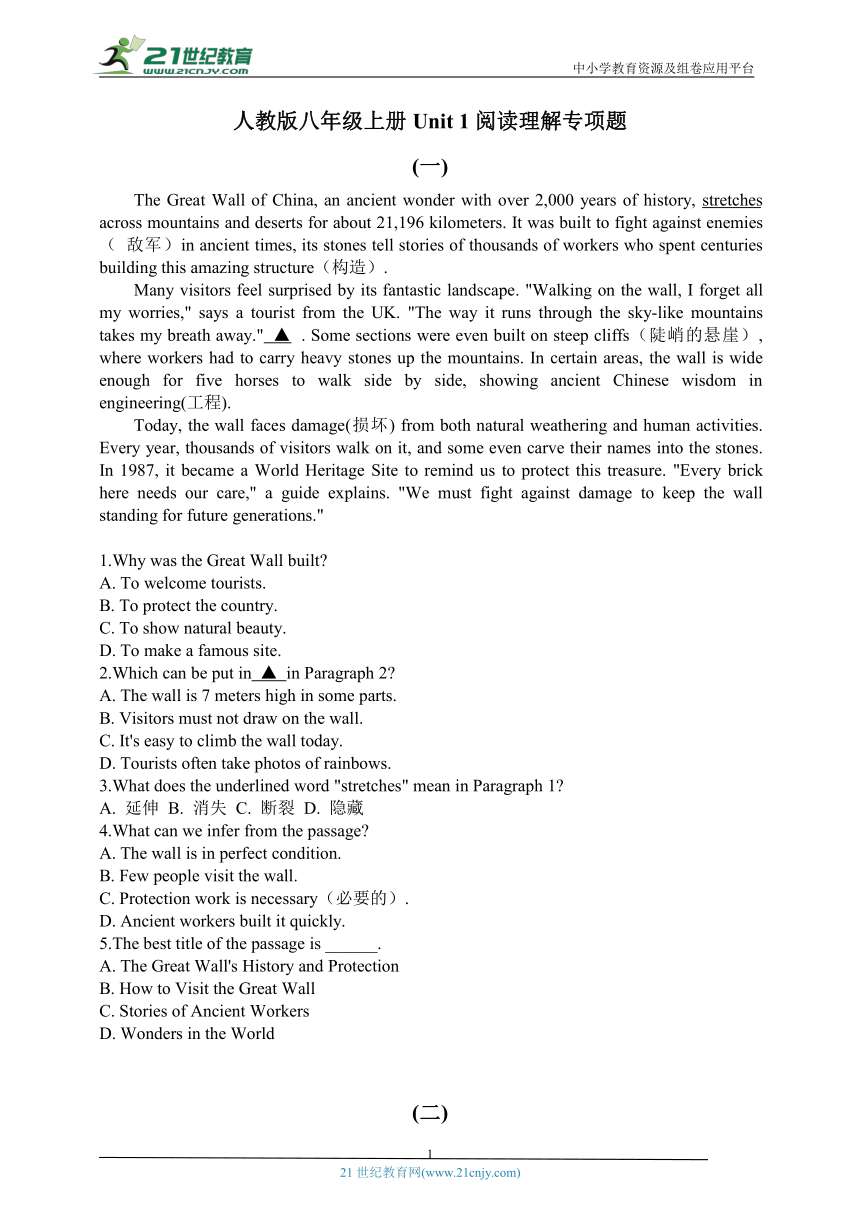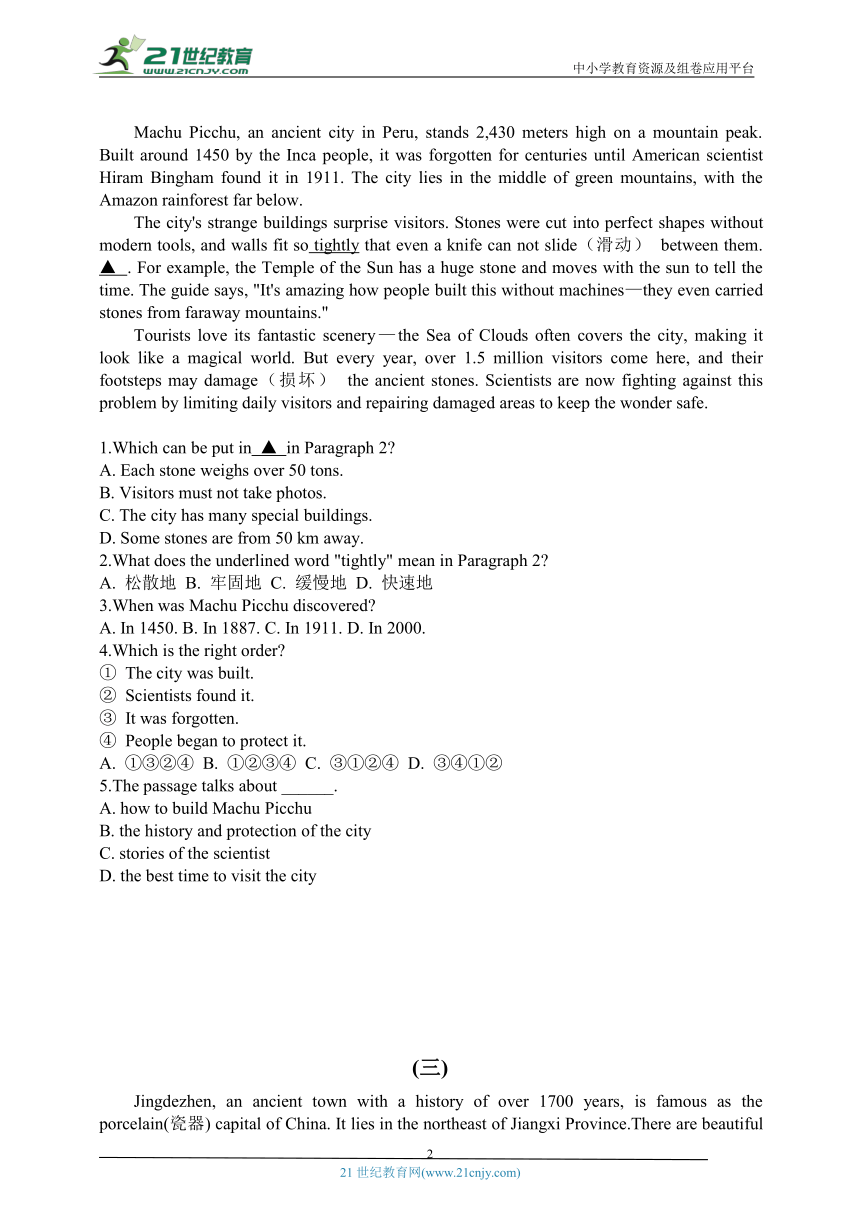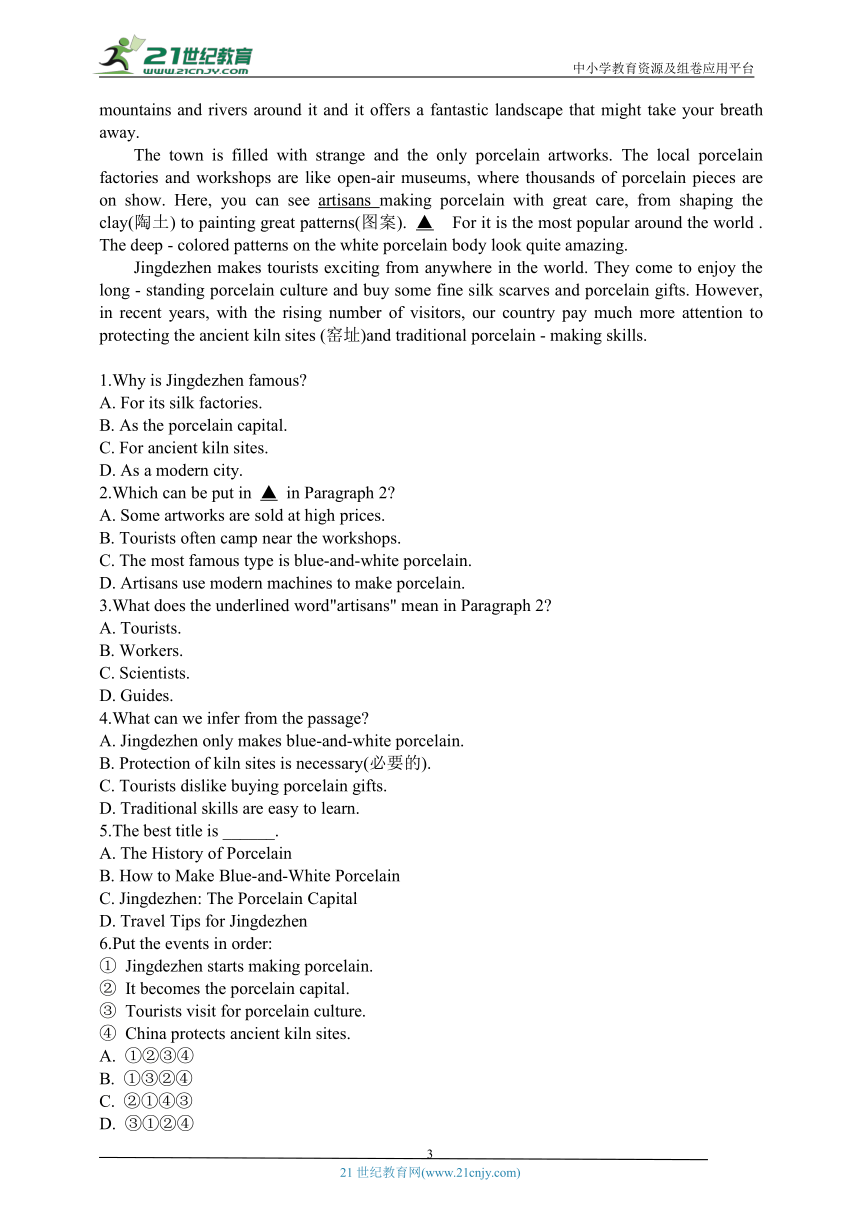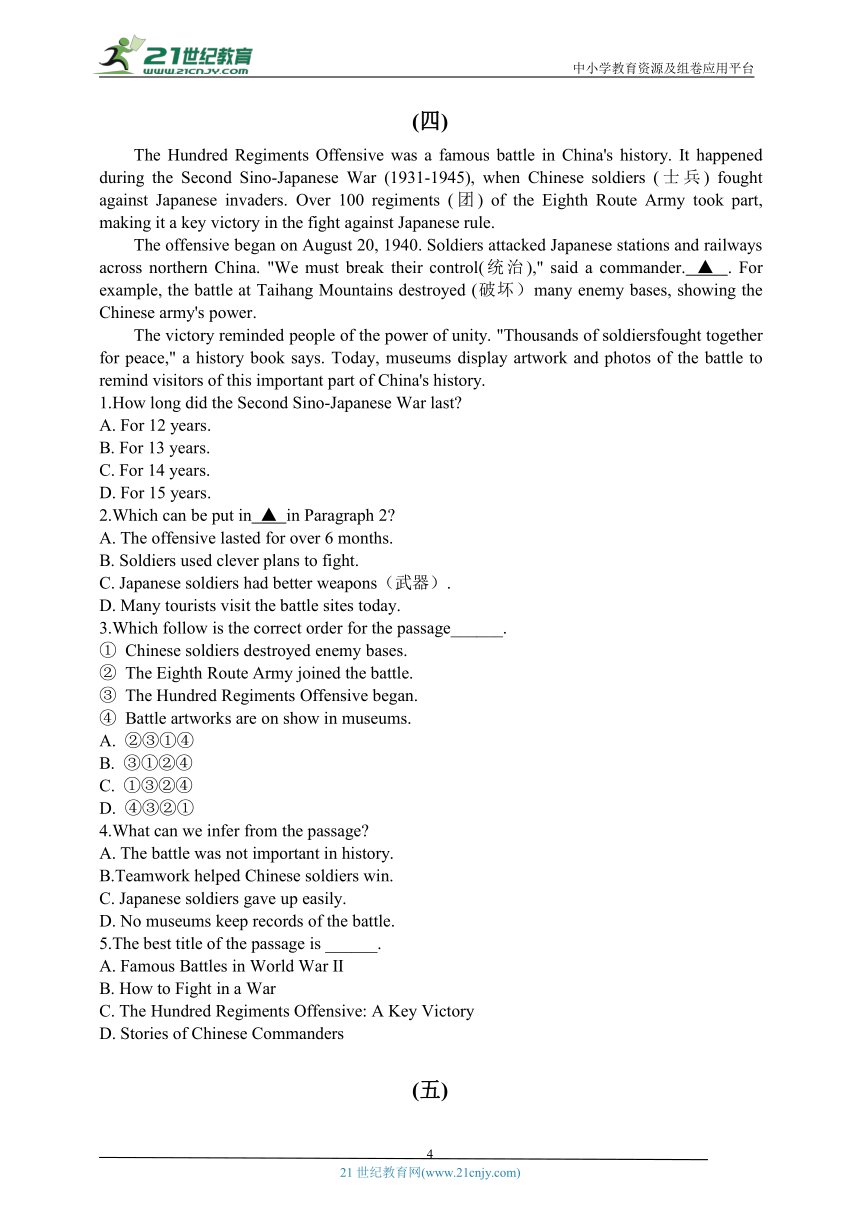Unit 1 Happy Holiday阅读理解专练【含答案解析】
文档属性
| 名称 | Unit 1 Happy Holiday阅读理解专练【含答案解析】 |  | |
| 格式 | doc | ||
| 文件大小 | 428.5KB | ||
| 资源类型 | 试卷 | ||
| 版本资源 | 人教版 | ||
| 科目 | 英语 | ||
| 更新时间 | 2025-07-03 22:09:07 | ||
图片预览




文档简介
中小学教育资源及组卷应用平台
人教版八年级上册Unit 1阅读理解专项题
(一)
The Great Wall of China, an ancient wonder with over 2,000 years of history, stretches across mountains and deserts for about 21,196 kilometers. It was built to fight against enemies( 敌军)in ancient times, its stones tell stories of thousands of workers who spent centuries building this amazing structure(构造).
Many visitors feel surprised by its fantastic landscape. "Walking on the wall, I forget all my worries," says a tourist from the UK. "The way it runs through the sky-like mountains takes my breath away." ▲ . Some sections were even built on steep cliffs(陡峭的悬崖), where workers had to carry heavy stones up the mountains. In certain areas, the wall is wide enough for five horses to walk side by side, showing ancient Chinese wisdom in engineering(工程).
Today, the wall faces damage(损坏) from both natural weathering and human activities. Every year, thousands of visitors walk on it, and some even carve their names into the stones. In 1987, it became a World Heritage Site to remind us to protect this treasure. "Every brick here needs our care," a guide explains. "We must fight against damage to keep the wall standing for future generations."
1.Why was the Great Wall built
A. To welcome tourists.
B. To protect the country.
C. To show natural beauty.
D. To make a famous site.
2.Which can be put in ▲ in Paragraph 2
A. The wall is 7 meters high in some parts.
B. Visitors must not draw on the wall.
C. It's easy to climb the wall today.
D. Tourists often take photos of rainbows.
3.What does the underlined word "stretches" mean in Paragraph 1
A. 延伸 B. 消失 C. 断裂 D. 隐藏
4.What can we infer from the passage
A. The wall is in perfect condition.
B. Few people visit the wall.
C. Protection work is necessary(必要的).
D. Ancient workers built it quickly.
5.The best title of the passage is ______.
A. The Great Wall's History and Protection
B. How to Visit the Great Wall
C. Stories of Ancient Workers
D. Wonders in the World
(二)
Machu Picchu, an ancient city in Peru, stands 2,430 meters high on a mountain peak. Built around 1450 by the Inca people, it was forgotten for centuries until American scientist Hiram Bingham found it in 1911. The city lies in the middle of green mountains, with the Amazon rainforest far below.
The city's strange buildings surprise visitors. Stones were cut into perfect shapes without modern tools, and walls fit so tightly that even a knife can not slide(滑动) between them. ▲ . For example, the Temple of the Sun has a huge stone and moves with the sun to tell the time. The guide says, "It's amazing how people built this without machines—they even carried stones from faraway mountains."
Tourists love its fantastic scenery—the Sea of Clouds often covers the city, making it look like a magical world. But every year, over 1.5 million visitors come here, and their footsteps may damage(损坏) the ancient stones. Scientists are now fighting against this problem by limiting daily visitors and repairing damaged areas to keep the wonder safe.
1.Which can be put in ▲ in Paragraph 2
A. Each stone weighs over 50 tons.
B. Visitors must not take photos.
C. The city has many special buildings.
D. Some stones are from 50 km away.
2.What does the underlined word "tightly" mean in Paragraph 2
A. 松散地 B. 牢固地 C. 缓慢地 D. 快速地
3.When was Machu Picchu discovered
A. In 1450. B. In 1887. C. In 1911. D. In 2000.
4.Which is the right order
① The city was built.
② Scientists found it.
③ It was forgotten.
④ People began to protect it.
A. ①③②④ B. ①②③④ C. ③①②④ D. ③④①②
5.The passage talks about ______.
A. how to build Machu Picchu
B. the history and protection of the city
C. stories of the scientist
D. the best time to visit the city
(三)
Jingdezhen, an ancient town with a history of over 1700 years, is famous as the porcelain(瓷器) capital of China. It lies in the northeast of Jiangxi Province.There are beautiful mountains and rivers around it and it offers a fantastic landscape that might take your breath away.
The town is filled with strange and the only porcelain artworks. The local porcelain factories and workshops are like open-air museums, where thousands of porcelain pieces are on show. Here, you can see artisans making porcelain with great care, from shaping the clay(陶土) to painting great patterns(图案). ▲ For it is the most popular around the world . The deep - colored patterns on the white porcelain body look quite amazing.
Jingdezhen makes tourists exciting from anywhere in the world. They come to enjoy the long - standing porcelain culture and buy some fine silk scarves and porcelain gifts. However, in recent years, with the rising number of visitors, our country pay much more attention to protecting the ancient kiln sites (窑址)and traditional porcelain - making skills.
1.Why is Jingdezhen famous
A. For its silk factories.
B. As the porcelain capital.
C. For ancient kiln sites.
D. As a modern city.
2.Which can be put in ▲ in Paragraph 2
A. Some artworks are sold at high prices.
B. Tourists often camp near the workshops.
C. The most famous type is blue-and-white porcelain.
D. Artisans use modern machines to make porcelain.
3.What does the underlined word"artisans" mean in Paragraph 2
A. Tourists.
B. Workers.
C. Scientists.
D. Guides.
4.What can we infer from the passage
A. Jingdezhen only makes blue-and-white porcelain.
B. Protection of kiln sites is necessary(必要的).
C. Tourists dislike buying porcelain gifts.
D. Traditional skills are easy to learn.
5.The best title is ______.
A. The History of Porcelain
B. How to Make Blue-and-White Porcelain
C. Jingdezhen: The Porcelain Capital
D. Travel Tips for Jingdezhen
6.Put the events in order:
① Jingdezhen starts making porcelain.
② It becomes the porcelain capital.
③ Tourists visit for porcelain culture.
④ China protects ancient kiln sites.
A. ①②③④
B. ①③②④
C. ②①④③
D. ③①②④
(四)
The Hundred Regiments Offensive was a famous battle in China's history. It happened during the Second Sino-Japanese War (1931-1945), when Chinese soldiers (士兵) fought against Japanese invaders. Over 100 regiments (团) of the Eighth Route Army took part, making it a key victory in the fight against Japanese rule.
The offensive began on August 20, 1940. Soldiers attacked Japanese stations and railways across northern China. "We must break their control(统治)," said a commander. ▲ . For example, the battle at Taihang Mountains destroyed (破坏)many enemy bases, showing the Chinese army's power.
The victory reminded people of the power of unity. "Thousands of soldiersfought together for peace," a history book says. Today, museums display artwork and photos of the battle to remind visitors of this important part of China's history.
1.How long did the Second Sino-Japanese War last
A. For 12 years.
B. For 13 years.
C. For 14 years.
D. For 15 years.
2.Which can be put in ▲ in Paragraph 2
A. The offensive lasted for over 6 months.
B. Soldiers used clever plans to fight.
C. Japanese soldiers had better weapons(武器).
D. Many tourists visit the battle sites today.
3.Which follow is the correct order for the passage______.
① Chinese soldiers destroyed enemy bases.
② The Eighth Route Army joined the battle.
③ The Hundred Regiments Offensive began.
④ Battle artworks are on show in museums.
A. ②③①④
B. ③①②④
C. ①③②④
D. ④③②①
4.What can we infer from the passage
A. The battle was not important in history.
B.Teamwork helped Chinese soldiers win.
C. Japanese soldiers gave up easily.
D. No museums keep records of the battle.
5.The best title of the passage is ______.
A. Famous Battles in World War II
B. How to Fight in a War
C. The Hundred Regiments Offensive: A Key Victory
D. Stories of Chinese Commanders
(五)
The Potala Palace, an ancient palace in Lhasa, Tibet, stands 3,700 meters above sea level. Built in the 7th century(世纪), it mixes traditional Tibetan architecture with fantastic landscape views. The palace's red and white walls tower into the sky, making it a symbol of peace and history.
Visitors are often surprised by its beauty. "The first sight of the palace takes my breath away," says a tourist. "The way it stands against the blue sky and white clouds is amazing." ▲ .The Palace Museum inside has thousands of artworks, including thangkas (唐卡) and statues.
During sunny days, the palace looks even more wonderful. The sunlight makes the golden roofs(屋顶) shine, and the nearby mountains create a magical landscape. Tourists from anywhere in the world come to take photos and feel the ancient culture. However, to protect the palace, visitors must follow strict rules.
1.When was the Potala Palace built
A. In the 7th century.
B. In the 17th century.
C. In 1940.
D. In 1987.
2.Which can be put in ▲ in Paragraph 2
A. The palace also has rich cultural treasures inside.
B. Tourists often camp near the palace.
C. The weather here is usually cold.
D. Many visitors feel bored with old buildings.
3.What does "tower" mean
A. To move quickly.
B. To stand tall.
C. To look beautiful.
D. To become famous.
4.What can we infer from the passage
A. The palace is only famous for its scenery.
B. Visitors can take any photos they want.
C. Cultural protection is important for the palace.
D. The palace has no rules for visitors.
5.The best title is ______.
A. Travel Tips for Lhasa
B. How to Protect Ancient Palaces
C. The Potala Palace: A Wonder of Scenery and Culture
D. Stories of Tibetan Architecture
答案与解析
(一)长城
B
解析:文中明确提到长城建造目的是 “fight against enemies”,即保护国家,故选 B。
A
解析:空格后描述长城建筑难度,A 选项 “部分段落高 7 米” 属于建筑细节,与后文 “宽可容五马并行” 呼应。
A
解析:根据 “across mountains and deserts” 可知 “stretches” 意为 “延伸”。
C
解析:文中提到长城需保护(1987 年列为世界遗产),推断保护工作必要,故选 C。
A
解析:文章围绕长城历史与保护展开,A 选项最全面。
(二)马丘比丘
C
解析:空格后以太阳神庙为例,C 选项 “城市有许多特殊建筑” 可引出具体案例。
B
解析:“walls fit tightly” 指墙壁贴合 “牢固地”,刀无法插入,故选 B。
C
解析:文中明确提到 1911 年被发现,故选 C。
A
解析:事件顺序为:建造→被遗忘→发现→保护,对应 A 选项。
B
解析:文章讲马丘比丘历史与保护,B 选项正确。
(三)景德镇
B
解析:首句点明景德镇为 “瓷器之都”,故选 B。
C
解析:空格后 “it” 指代青花瓷,C 选项 “最著名的是青花瓷” 衔接后文。
B
解析:“artisans making porcelain” 指制作瓷器的 “工人”,故选 B。
B
解析:文中提到 “保护窑址”,推断保护必要,故选 B。
C
解析:文章围绕景德镇 “瓷器之都” 展开,C 选项正确。
A
解析:顺序为:开始制瓷→成为瓷都→游客参观→保护窑址,选 A。
(四)百团大战
C
解析:1931-1945 年共 14 年,故选 C。
B
解析:空格后举例战术成功,B 选项 “士兵用巧妙计划作战” 衔接后文。
A
解析:顺序为:八路军参战→战役开始→摧毁基地→博物馆展出,选 A。
B
解析:文中强调 “unity(团结)”,推断团队合作助胜利,故选 B。
C
解析:文章围绕百团大战的胜利意义展开,C 选项正确。
(五)布达拉宫
A
解析:文中明确提到建于 7 世纪,故选 A。
A
解析:空格后讲宫内艺术品,A 选项 “宫内有文化宝藏” 衔接后文。
B
解析:“tower into the sky” 指 “高耸”,故选 B。
C
解析:文中提到 “follow strict rules”,推断文化保护重要,故选 C。
C
解析:文章讲布达拉宫的风景与文化,C 选项正确。
答案速查
(一) 1-5 BAACA
(二) 1-5 CBCAB
(三) 1-6 BCBBCA
(四) 1-5 CBABC
(五) 1-5 AABCC
21世纪教育网 www.21cnjy.com 精品试卷·第 2 页 (共 2 页)
HYPERLINK "http://21世纪教育网(www.21cnjy.com)
" 21世纪教育网(www.21cnjy.com)
人教版八年级上册Unit 1阅读理解专项题
(一)
The Great Wall of China, an ancient wonder with over 2,000 years of history, stretches across mountains and deserts for about 21,196 kilometers. It was built to fight against enemies( 敌军)in ancient times, its stones tell stories of thousands of workers who spent centuries building this amazing structure(构造).
Many visitors feel surprised by its fantastic landscape. "Walking on the wall, I forget all my worries," says a tourist from the UK. "The way it runs through the sky-like mountains takes my breath away." ▲ . Some sections were even built on steep cliffs(陡峭的悬崖), where workers had to carry heavy stones up the mountains. In certain areas, the wall is wide enough for five horses to walk side by side, showing ancient Chinese wisdom in engineering(工程).
Today, the wall faces damage(损坏) from both natural weathering and human activities. Every year, thousands of visitors walk on it, and some even carve their names into the stones. In 1987, it became a World Heritage Site to remind us to protect this treasure. "Every brick here needs our care," a guide explains. "We must fight against damage to keep the wall standing for future generations."
1.Why was the Great Wall built
A. To welcome tourists.
B. To protect the country.
C. To show natural beauty.
D. To make a famous site.
2.Which can be put in ▲ in Paragraph 2
A. The wall is 7 meters high in some parts.
B. Visitors must not draw on the wall.
C. It's easy to climb the wall today.
D. Tourists often take photos of rainbows.
3.What does the underlined word "stretches" mean in Paragraph 1
A. 延伸 B. 消失 C. 断裂 D. 隐藏
4.What can we infer from the passage
A. The wall is in perfect condition.
B. Few people visit the wall.
C. Protection work is necessary(必要的).
D. Ancient workers built it quickly.
5.The best title of the passage is ______.
A. The Great Wall's History and Protection
B. How to Visit the Great Wall
C. Stories of Ancient Workers
D. Wonders in the World
(二)
Machu Picchu, an ancient city in Peru, stands 2,430 meters high on a mountain peak. Built around 1450 by the Inca people, it was forgotten for centuries until American scientist Hiram Bingham found it in 1911. The city lies in the middle of green mountains, with the Amazon rainforest far below.
The city's strange buildings surprise visitors. Stones were cut into perfect shapes without modern tools, and walls fit so tightly that even a knife can not slide(滑动) between them. ▲ . For example, the Temple of the Sun has a huge stone and moves with the sun to tell the time. The guide says, "It's amazing how people built this without machines—they even carried stones from faraway mountains."
Tourists love its fantastic scenery—the Sea of Clouds often covers the city, making it look like a magical world. But every year, over 1.5 million visitors come here, and their footsteps may damage(损坏) the ancient stones. Scientists are now fighting against this problem by limiting daily visitors and repairing damaged areas to keep the wonder safe.
1.Which can be put in ▲ in Paragraph 2
A. Each stone weighs over 50 tons.
B. Visitors must not take photos.
C. The city has many special buildings.
D. Some stones are from 50 km away.
2.What does the underlined word "tightly" mean in Paragraph 2
A. 松散地 B. 牢固地 C. 缓慢地 D. 快速地
3.When was Machu Picchu discovered
A. In 1450. B. In 1887. C. In 1911. D. In 2000.
4.Which is the right order
① The city was built.
② Scientists found it.
③ It was forgotten.
④ People began to protect it.
A. ①③②④ B. ①②③④ C. ③①②④ D. ③④①②
5.The passage talks about ______.
A. how to build Machu Picchu
B. the history and protection of the city
C. stories of the scientist
D. the best time to visit the city
(三)
Jingdezhen, an ancient town with a history of over 1700 years, is famous as the porcelain(瓷器) capital of China. It lies in the northeast of Jiangxi Province.There are beautiful mountains and rivers around it and it offers a fantastic landscape that might take your breath away.
The town is filled with strange and the only porcelain artworks. The local porcelain factories and workshops are like open-air museums, where thousands of porcelain pieces are on show. Here, you can see artisans making porcelain with great care, from shaping the clay(陶土) to painting great patterns(图案). ▲ For it is the most popular around the world . The deep - colored patterns on the white porcelain body look quite amazing.
Jingdezhen makes tourists exciting from anywhere in the world. They come to enjoy the long - standing porcelain culture and buy some fine silk scarves and porcelain gifts. However, in recent years, with the rising number of visitors, our country pay much more attention to protecting the ancient kiln sites (窑址)and traditional porcelain - making skills.
1.Why is Jingdezhen famous
A. For its silk factories.
B. As the porcelain capital.
C. For ancient kiln sites.
D. As a modern city.
2.Which can be put in ▲ in Paragraph 2
A. Some artworks are sold at high prices.
B. Tourists often camp near the workshops.
C. The most famous type is blue-and-white porcelain.
D. Artisans use modern machines to make porcelain.
3.What does the underlined word"artisans" mean in Paragraph 2
A. Tourists.
B. Workers.
C. Scientists.
D. Guides.
4.What can we infer from the passage
A. Jingdezhen only makes blue-and-white porcelain.
B. Protection of kiln sites is necessary(必要的).
C. Tourists dislike buying porcelain gifts.
D. Traditional skills are easy to learn.
5.The best title is ______.
A. The History of Porcelain
B. How to Make Blue-and-White Porcelain
C. Jingdezhen: The Porcelain Capital
D. Travel Tips for Jingdezhen
6.Put the events in order:
① Jingdezhen starts making porcelain.
② It becomes the porcelain capital.
③ Tourists visit for porcelain culture.
④ China protects ancient kiln sites.
A. ①②③④
B. ①③②④
C. ②①④③
D. ③①②④
(四)
The Hundred Regiments Offensive was a famous battle in China's history. It happened during the Second Sino-Japanese War (1931-1945), when Chinese soldiers (士兵) fought against Japanese invaders. Over 100 regiments (团) of the Eighth Route Army took part, making it a key victory in the fight against Japanese rule.
The offensive began on August 20, 1940. Soldiers attacked Japanese stations and railways across northern China. "We must break their control(统治)," said a commander. ▲ . For example, the battle at Taihang Mountains destroyed (破坏)many enemy bases, showing the Chinese army's power.
The victory reminded people of the power of unity. "Thousands of soldiersfought together for peace," a history book says. Today, museums display artwork and photos of the battle to remind visitors of this important part of China's history.
1.How long did the Second Sino-Japanese War last
A. For 12 years.
B. For 13 years.
C. For 14 years.
D. For 15 years.
2.Which can be put in ▲ in Paragraph 2
A. The offensive lasted for over 6 months.
B. Soldiers used clever plans to fight.
C. Japanese soldiers had better weapons(武器).
D. Many tourists visit the battle sites today.
3.Which follow is the correct order for the passage______.
① Chinese soldiers destroyed enemy bases.
② The Eighth Route Army joined the battle.
③ The Hundred Regiments Offensive began.
④ Battle artworks are on show in museums.
A. ②③①④
B. ③①②④
C. ①③②④
D. ④③②①
4.What can we infer from the passage
A. The battle was not important in history.
B.Teamwork helped Chinese soldiers win.
C. Japanese soldiers gave up easily.
D. No museums keep records of the battle.
5.The best title of the passage is ______.
A. Famous Battles in World War II
B. How to Fight in a War
C. The Hundred Regiments Offensive: A Key Victory
D. Stories of Chinese Commanders
(五)
The Potala Palace, an ancient palace in Lhasa, Tibet, stands 3,700 meters above sea level. Built in the 7th century(世纪), it mixes traditional Tibetan architecture with fantastic landscape views. The palace's red and white walls tower into the sky, making it a symbol of peace and history.
Visitors are often surprised by its beauty. "The first sight of the palace takes my breath away," says a tourist. "The way it stands against the blue sky and white clouds is amazing." ▲ .The Palace Museum inside has thousands of artworks, including thangkas (唐卡) and statues.
During sunny days, the palace looks even more wonderful. The sunlight makes the golden roofs(屋顶) shine, and the nearby mountains create a magical landscape. Tourists from anywhere in the world come to take photos and feel the ancient culture. However, to protect the palace, visitors must follow strict rules.
1.When was the Potala Palace built
A. In the 7th century.
B. In the 17th century.
C. In 1940.
D. In 1987.
2.Which can be put in ▲ in Paragraph 2
A. The palace also has rich cultural treasures inside.
B. Tourists often camp near the palace.
C. The weather here is usually cold.
D. Many visitors feel bored with old buildings.
3.What does "tower" mean
A. To move quickly.
B. To stand tall.
C. To look beautiful.
D. To become famous.
4.What can we infer from the passage
A. The palace is only famous for its scenery.
B. Visitors can take any photos they want.
C. Cultural protection is important for the palace.
D. The palace has no rules for visitors.
5.The best title is ______.
A. Travel Tips for Lhasa
B. How to Protect Ancient Palaces
C. The Potala Palace: A Wonder of Scenery and Culture
D. Stories of Tibetan Architecture
答案与解析
(一)长城
B
解析:文中明确提到长城建造目的是 “fight against enemies”,即保护国家,故选 B。
A
解析:空格后描述长城建筑难度,A 选项 “部分段落高 7 米” 属于建筑细节,与后文 “宽可容五马并行” 呼应。
A
解析:根据 “across mountains and deserts” 可知 “stretches” 意为 “延伸”。
C
解析:文中提到长城需保护(1987 年列为世界遗产),推断保护工作必要,故选 C。
A
解析:文章围绕长城历史与保护展开,A 选项最全面。
(二)马丘比丘
C
解析:空格后以太阳神庙为例,C 选项 “城市有许多特殊建筑” 可引出具体案例。
B
解析:“walls fit tightly” 指墙壁贴合 “牢固地”,刀无法插入,故选 B。
C
解析:文中明确提到 1911 年被发现,故选 C。
A
解析:事件顺序为:建造→被遗忘→发现→保护,对应 A 选项。
B
解析:文章讲马丘比丘历史与保护,B 选项正确。
(三)景德镇
B
解析:首句点明景德镇为 “瓷器之都”,故选 B。
C
解析:空格后 “it” 指代青花瓷,C 选项 “最著名的是青花瓷” 衔接后文。
B
解析:“artisans making porcelain” 指制作瓷器的 “工人”,故选 B。
B
解析:文中提到 “保护窑址”,推断保护必要,故选 B。
C
解析:文章围绕景德镇 “瓷器之都” 展开,C 选项正确。
A
解析:顺序为:开始制瓷→成为瓷都→游客参观→保护窑址,选 A。
(四)百团大战
C
解析:1931-1945 年共 14 年,故选 C。
B
解析:空格后举例战术成功,B 选项 “士兵用巧妙计划作战” 衔接后文。
A
解析:顺序为:八路军参战→战役开始→摧毁基地→博物馆展出,选 A。
B
解析:文中强调 “unity(团结)”,推断团队合作助胜利,故选 B。
C
解析:文章围绕百团大战的胜利意义展开,C 选项正确。
(五)布达拉宫
A
解析:文中明确提到建于 7 世纪,故选 A。
A
解析:空格后讲宫内艺术品,A 选项 “宫内有文化宝藏” 衔接后文。
B
解析:“tower into the sky” 指 “高耸”,故选 B。
C
解析:文中提到 “follow strict rules”,推断文化保护重要,故选 C。
C
解析:文章讲布达拉宫的风景与文化,C 选项正确。
答案速查
(一) 1-5 BAACA
(二) 1-5 CBCAB
(三) 1-6 BCBBCA
(四) 1-5 CBABC
(五) 1-5 AABCC
21世纪教育网 www.21cnjy.com 精品试卷·第 2 页 (共 2 页)
HYPERLINK "http://21世纪教育网(www.21cnjy.com)
" 21世纪教育网(www.21cnjy.com)
同课章节目录
